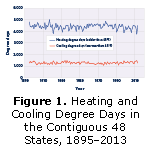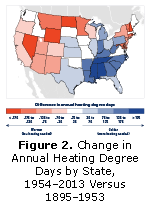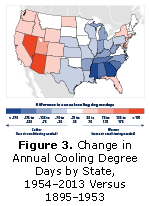Climate Change
Climate Change Indicators in the United States
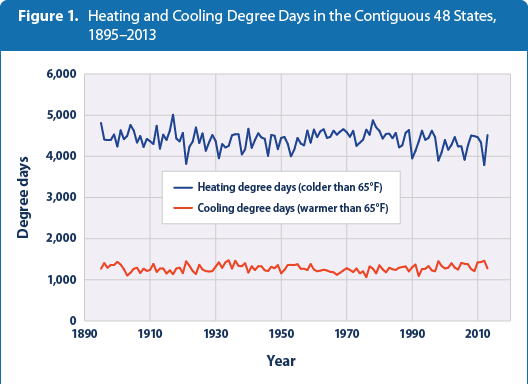
Data source: NOAA, 2014 3
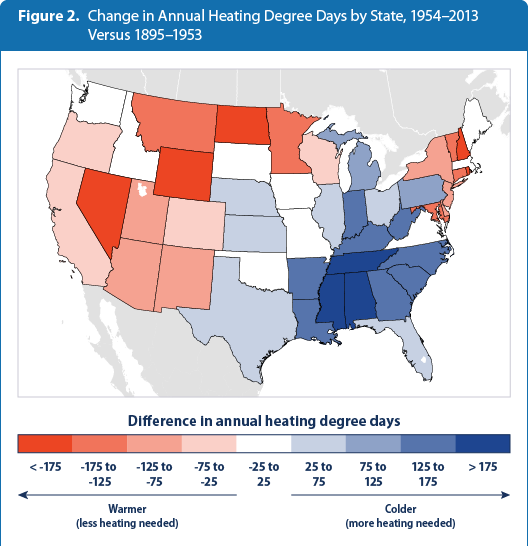
Data source: NOAA, 2014 4
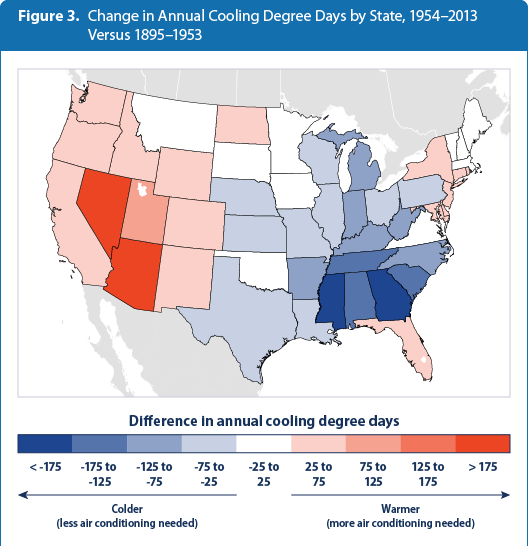
Data source: NOAA, 2014 5
Click a state (or Ctrl-click multiple states) to display a graph of data over time.
Share this indicator:
![]()
![]()
![]() Web update: November 2014
Web update: November 2014
Data source: NOAA, 2014 3
Click a state (or Ctrl-click multiple states) to display a graph of data over time.
Share this indicator:
![]()
![]()
![]() Web update: November 2014
Web update: November 2014
Data source: NOAA, 2014 3
Key Points
- Heating degree days have declined in recent years as the U.S. climate has warmed (see Figure 1). This change suggests that heating needs have decreased overall.
- Overall, cooling degree days have not increased significantly over the past 100 years. However, a slight increase is evident over the past few decades, suggesting that air conditioning energy demand has also been increasing recently (see Figure 1).
- Heating degree days have generally decreased in the North and West, and cooling degree days have generally increased in the West. The Southeast has seen the opposite: more heating degree days and fewer cooling degree days (see Figures 2 and 3).
Background
Outdoor temperatures can affect daily life in many ways. In particular, temperature affects our comfort level and our demand for heating and air conditioning. Collectively, heating and cooling the spaces in which we live accounts for 48 percent of the energy that American households use every year. 1 As climate change contributes to an increase in average temperatures, an increase in unusually hot days, and a decrease in unusually cold days (see the U.S. and Global Temperature and High and Low Temperatures indicators), the overall demand for heating is expected to decline and the demand for cooling is expected to increase.
One way to measure the influence of temperature change on heating and cooling needs is using heating and cooling degree days, which measure the difference between outdoor temperatures and a temperature that people generally find comfortable indoors. These measurements suggest how much energy people might need to use to heat and cool their homes and workplaces, thus providing a sense of how climate change could affect people's daily lives and finances.
About the Indicator
This indicator uses daily temperature data from thousands of weather stations across the United States to calculate heating and cooling degree days. A "degree day" is determined by comparing the daily average outdoor temperature with a defined baseline temperature for indoor comfort (in this case, 65°F). For example, if the average temperature on a particular day is 78°F, then that day counts as 13 cooling degree days, as a building's interior would need to be cooled by 13°F to reach 65°F. Conversely, if the average outdoor temperature is 34°F, then that day counts as 31 heating degree days, as a building's interior would need to be warmed by 31°F to reach 65°F. For reference, New York City experiences far more heating degree days than cooling degree days per year—a reflection of the relatively cool climate in the Northeast—while Houston, Texas, has far more cooling degree days than heating degree days—a reflection of the much warmer climate in the South. 2
Figure 1 shows each year's average heating and cooling degree days across the contiguous 48 states. Figures 2 and 3 show how heating and cooling degree days have changed by state, based on a comparison of the first 59 years of available data (1895–1953) with the most recent 60 years (1954–2013). State and national averages were calculated by finding the total number of heating and cooling degree days per year at each weather station, averaging the results from all stations within regions called climate divisions (each state has up to 10 climate divisions), then calculating state and national averages weighted by the population of each climate division. With this population-weighting approach, average state and national heating and cooling degree days more closely reflect the conditions that the average resident would experience.
Indicator Notes
Heating and cooling degree days suggest how temperature changes affect energy demand, but they do not necessarily reflect actual energy use. Many other factors have influenced energy demand over time, such as more energy-efficient heating systems, the introduction and increasingly widespread use of cooling technologies, larger but better-insulated homes, behavior change, and population shifts (such as more people moving to warmer regions). All of the population-weighting in this indicator is based on the population distribution according to the 1990 U.S. Census, so any changes in heating and cooling degree days over time in this indicator reflect actual changes in the climate, not the influence of shifting populations. A nationally applied baseline—in this case, 65°F—has certain limitations considering the various climate regimes across the United States.
Data Sources
The data for this indicator were provided by the National Oceanic and Atmospheric Administration's National Climatic Data Center, which maintains a large collection of climate data online at: www.ncdc.noaa.gov/oa/
ncdc.html.
Technical Documentation
- Download related technical information PDF (6 pp, 202K)



